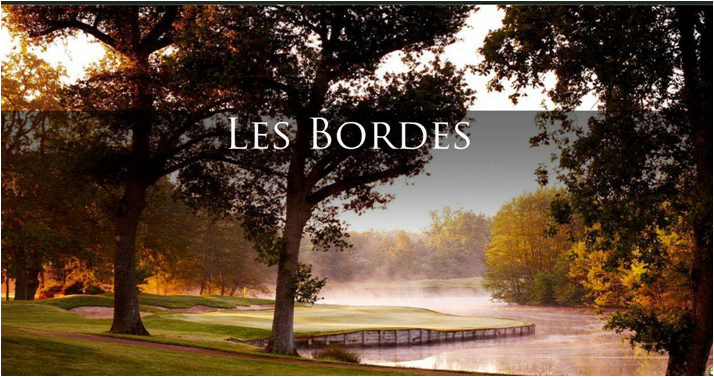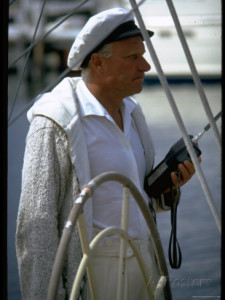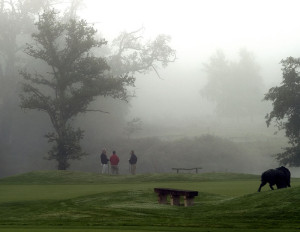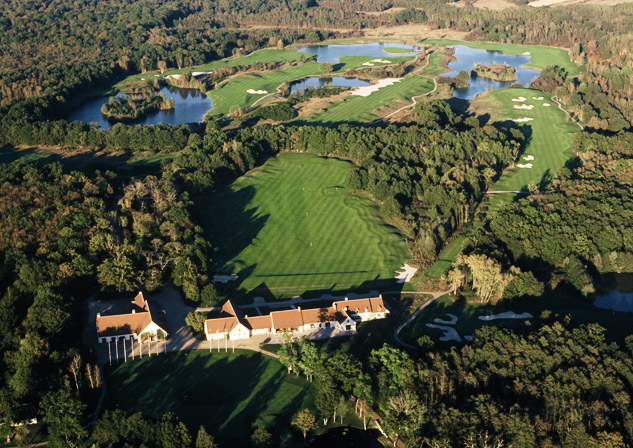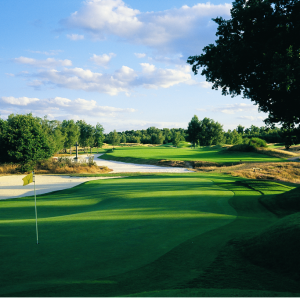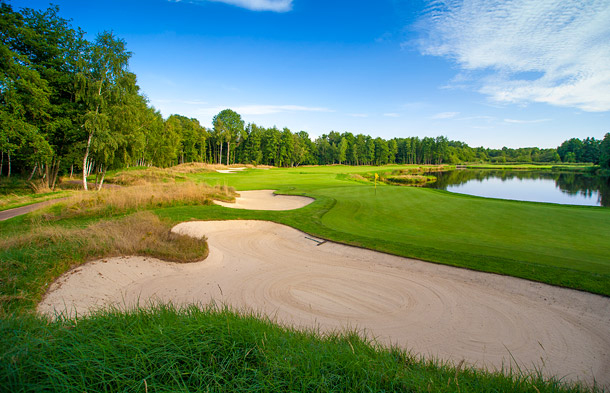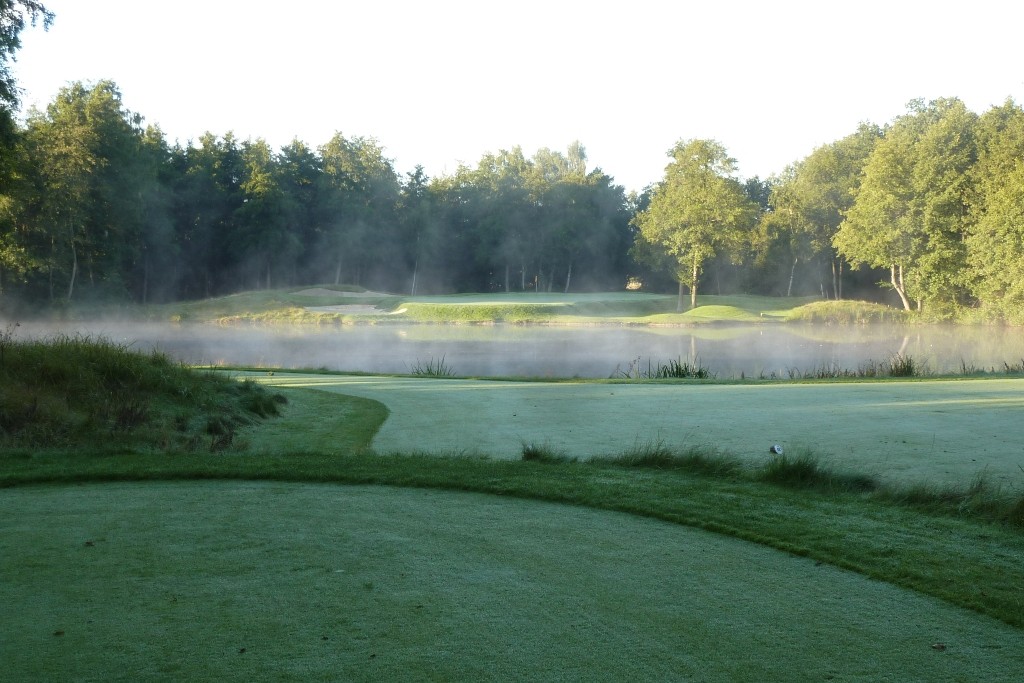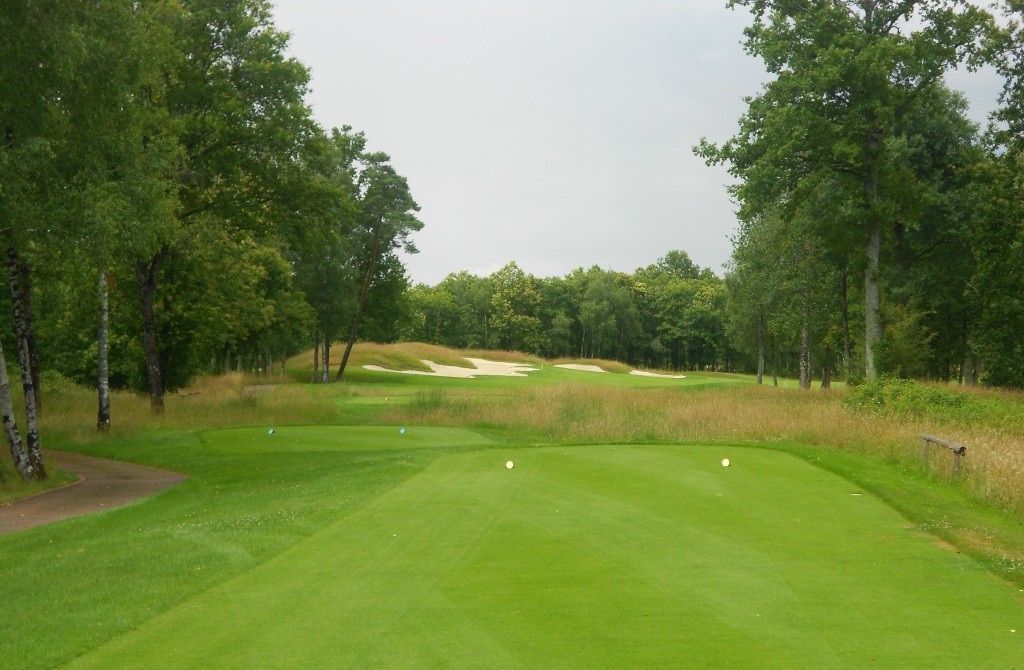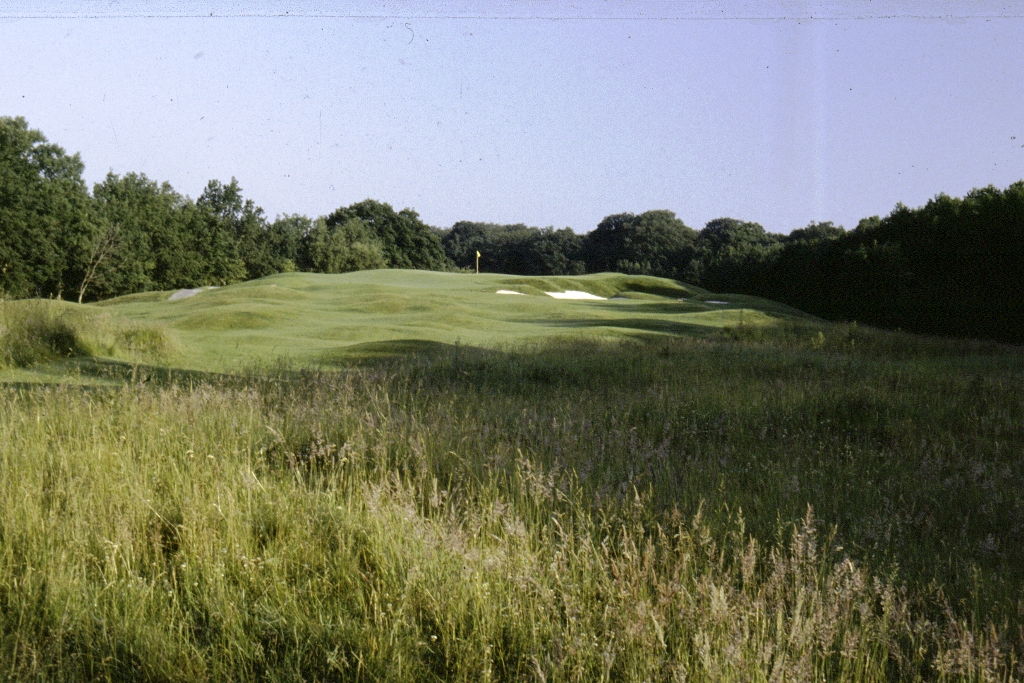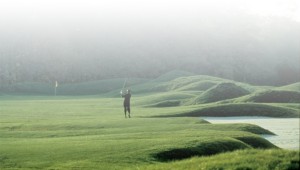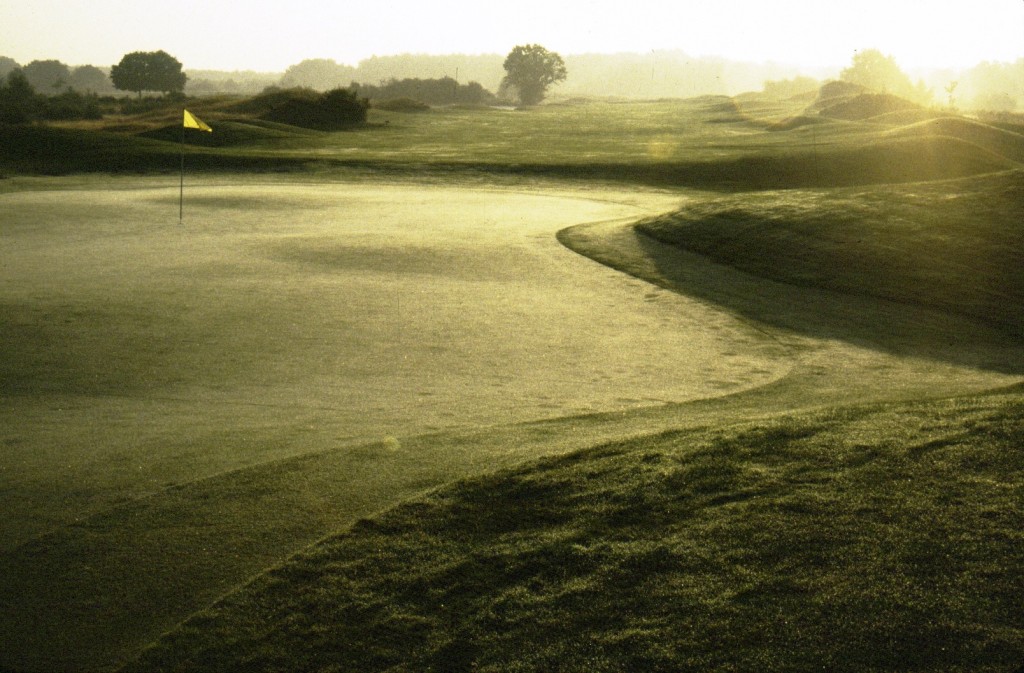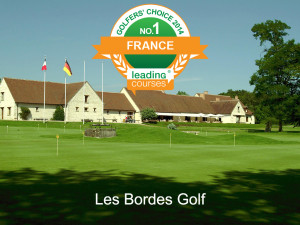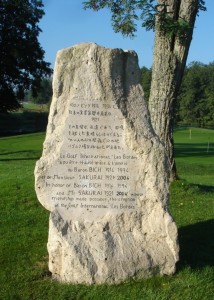I was recently asked to provide answers to some questions about Les Bordes for a magazine article. This gave me the opportunity to commit to writing, many of my experiences and memories associated with Les Bordes. I had the distinct honor of working with Mr. von Hagge during the creation of the golf course. As the “project Architect”, I was tasked with man of the less glamorous responsibilities associated with the making of a golf course. In short, I had a front row seat, to witness the evolution of what has become Europe’s #1 golf course (according to GolfWorld).
1 Had you been to France before you worked on Les Bordes? Or Europe?
I visited Europe (France, Italy, Germany, Switzerland, Austria) after my first year of college. It was a tourist visit. But, I was also starting a degree in Landscape Architecture, which made the trip more compelling. (Full disclosure – I am Catholic, and have a particular appreciation for classic architecture and sculpture. We visited about as many monuments, museums, buildings, churches and works of art – we could squeeze into the three week trip.)
2 What did Mr. Von Hagge tell you about the job – the client and the area – before you arrived?
While working in Japan, Robert befriended Yoshi Endo, a prominent Japanese golfer and golf consultant. Some years later, Mr. Yoshiki Sakurai1 asked Mr. Endo to identify a golf architect to design a golf course in France. Robert received a call from Yoshi Endo, and was told to expect a call from Baron Bich2.
Some days later, Robert did receive a call from France. Robert always represented it as a “mysterious” call, in the sense that it was quick and not completely comprehensible. By the end of the call, what was clear is; there was a first class round trip ticket to Paris awaiting him with Air France.
Robert flew to Paris and was picked up at the airport and taken directly to Baron Bich’s house. Robert would recount two memorable moments from this first meeting:
- He was taken by the paintings he saw on the wall. He remarked how one of paintings was very reminiscent of, and a striking likeness of a Van Gogh which Robert liked. To which Baron Bich replied, “It is not a good likeness. It is the original.”
- Later in the evening, Baron Bich was showing Robert a map of the property. When Robert pulled out his Shaeffer pen to make some notes. Baron Bich stopped Robert, handing him a Bic pen, saying he would prefer if Robert used a Bic pen. Robert would say that this when he finally made the “Bic” connection. (I’m not sure if this is actually the case. Robert was a master story teller. And, he was not above embellishing facts for added effect.)
It was during this initial meeting that Baron Bich explained his intention for the golf course: He wanted Les Bordes to be a golf course capable of training French golfer’s to internationally competitive. According to Robert, Mr. Bich felt French professional golfer’s weren’t competitive at an international level because they had too few “international” standard golf courses. (Baron Bich sponsored Jean van de Velde for several years. And, Mr. van de Velde would visit and play Les Bordes.)
When their meetings from this first visit were concluded, Baron Bich asked Robert send his impressions in a hand written report. Baron Bich was proponent of “Graphology” and he intended to make his own assessment of Robert’s psyche and personality characteristics.
There’s no other way to say it: Robert returned to Houston “ecstatic” with the prospect of designing Les Bordes.
Background information:
Two events occurred and lead Baron Bich and Yoshiaki Sakurai to build a golf course on Baron Bich’s hunting estate:
- Baron Bich’s doctor suggested he should take up golf for the exercise benefits. He quickly became enamored with golf. He often played at Morfontaine. He was openly impressed with Valderamma, expressing appreciation for the owner’s (Sr. Jaime Ortiz-Petiño) unwavering pursuit for perfection.
Bich expanded business to Japan and this led to a connection with Yoshiaki Sakurai. Mr. Sakurai happened to be a passionate golfer. He was expanding his global golf portfolio. (Generally, he was buying existing golf courses near major cities around the world. My understanding is; Sakurai was involved with Japan Airlines and his intention was to have a golf facility available near each major city, for traveling Japanese golfers. He would eventually grow his portfolio to 48 golf courses. I think the only “newly built” golf courses he was involved with were Les Bordes and one in Dusseldorf.)
3 What were your first impressions of the site?
I was admittedly foggy the first time I saw Les Bordes. Robert and I flew overnight, arriving in Paris early in the morning. I had been to Europe before. Still – being driven from Charles DeGualle airport to downtown – the sheer number of apartment buildings, looking like oversize file cabinets littering the morning landscape – was astonishing.
We arrived at Hotel Mont Thabor, a small non-descript hotel near the Louvre. The hotel was Japanese owned and featured a first class sushi restaurant on the ground floor (where I would soon experience my first ever sushi – for breakfast no less).
Upon arrival, we were met in the lobby by Mr. Sakurai’s representative and asked to join a meeting in progress in Mr. Sakurai’s room. We deposited our luggage in our respective rooms and reported to Mr. Sakurai’s room, where I remember the door opening to a room full of smoke – mainly. I could make out some figures in the recesses of the room. There were quick introductions, after which I was summarily dismissed. (Mr. Sakurai could be inhospitable – a mannerism which, years later, would lead to heated confrontation with Mr. von Hagge, which eventually severed our ties with Mr. Sakurai). Although slightly awkward for me, I welcomed the chance to retreat to my room to recuperate some sleep, which I missed on the flight. It was a short sleep though.
It seemed like my head no sooner hit the pillow than my phone rang, with Robert telling me I needed to “meet them for breakfast” in the lobby restaurant. And, what a memorable breakfast it was – sushi and Kirin (Japanese beer). Sushi, I am confident, can be considered an acquired taste – requiring a gradual introduction and measured progression toward appreciation. This was not experience. I was thrown in the deep end of the pool. I’m not sure of all I ate that morning, but much of it was still moving, quivering actually. I would eventually learn to love sushi, but that morning at the Mont Thabor, Kirin was my friend.
We were driven to Les Bordes in a Range Rover, which actually broke down near Orleans (about 20 minutes from Les Bordes). We arrived and gathered near (what is now) the practice tee. There was a large make-shift table with our concept plan taped to it. I remember Baron Bich, Madame Bich, Sakurai and Robert huddled over the plans – pointing out the practice area, the clubhouse, etc.
We made a small tour of the property. Honestly, it was early in my career. And, even though I was able to appreciate the quality of the landscape, I was not yet able to fully discern how the golf course would wind its way through the property.
I remember mostly attempting to process what was transpiring. Robert led the discussion and tour. I remember feeling Mr. Bich and Mr. Sakurai did not fully comprehend Robert’s vision – and, the scale of the intended design. But, I must admit, I didn’t either.
4 Can you remember how many holes, and which ones, on the existing course came from the two proposed 18 holers?
I can’t remember any of the original 36 hole concept plan. These plans, along with all our other original plans of Les Bordes, were destroyed in an office fire.
On reflection, what is startling is; we didn’t make multiple revisions or refinements to the initial Les Bordes plan. This original concept was submitted to the authorities. After some weeks, Baron Bich informed us that tree clearing permission was going to be complicated and take time. In order to avoid delaying the project start, he asked if it was possible to devise an 18 hole course which minimized the forest impact (clearing), so we could advance the work. We selected the golf holes which would require the least amount of tree clearing and the result is the present routing.
5 Were there difficulties in working the site and how long did it take?
It took two and one-half years from start of construction to opening. The construction process was convoluted. First, there were several different nationalities involved. Secondly, there weren’t any “experienced” golf course contractors or companies specializing in golf construction, in France at that time.
Sakurai wanted Taisai – which was a large Japanese engineering and construction company, involved in the project. Taisai had an office in England. So, we had an English representative of Taisai to manage the project. But, they didn’t have a golf expert on staff.
Robert, by coincidence, had worked with Taisai in Japan and had befriended a Japanese engineer “Bill” Kasai. Mr. Kasai was semi-retired but was much honored to be invited to the project. He brought an assistant, Mr. Sakata. Mr. Sakata was essentially the day to day construction superintendent (responsable – as they say in France) for Taisai.
So, what do we have:
- French and Japanese client
- An American golf architecture firm – doing its first project in Europe.
- Japanese management company – two Japanese construction superintendents (who don’t know anything about France, it’s language or it’s unique working style/customs)
- English manager – working for a Japanese construction company – to oversee the construction French legal issues.
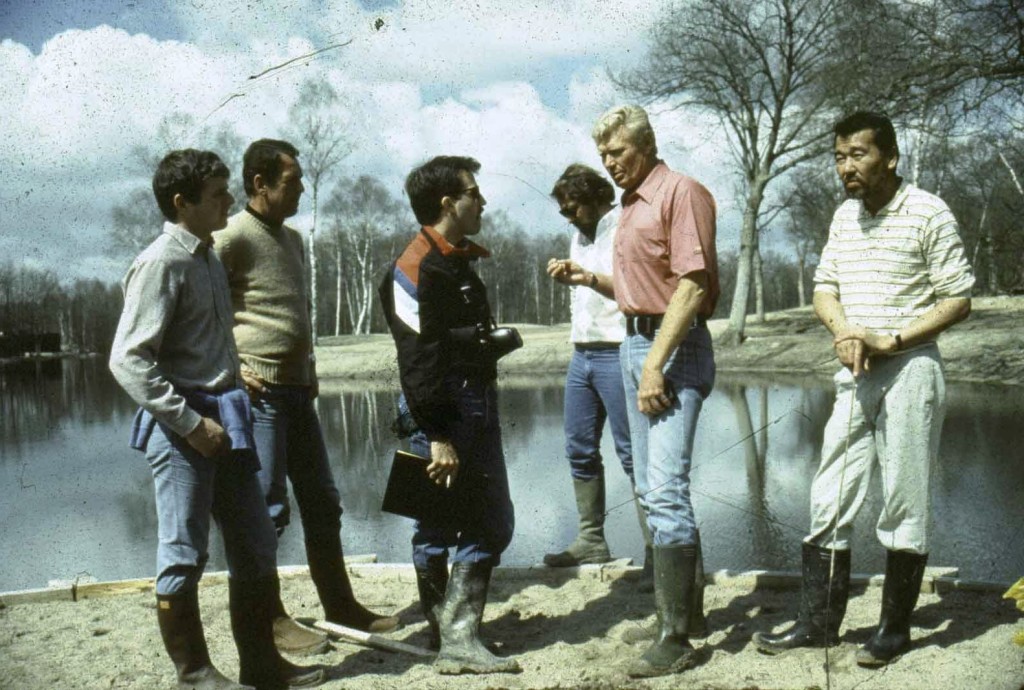
circa 1986 Les Bordes construction – 18th green looking back toward 18 fairway – Robert and Rick discussing – Michel Sapak (L) and Mr. Sakata (R) ©vhsb
We developed the construction drawings and specifications for the golf course. Taisai/London checked all documents to assure they were suitable for the French market. Then, Taisai undertook the tendering process (this is not normal – we are normally involved in the process).
The next step – and, this is only the beginning of the “journey”… We received notice to visit the site because construction was beginning. When we arrived at Les Bordes, we learned that, due to the size of the project, it was not possible for one contractor to accomplish the work. Therefore, three contractors had been awarded the contract. This was confusing for us. We had never encountered this problem before. And, while we were attempting to figure out, through translation, which tasks were assigned to which contractor, we learned even more distressing news. The individual tasks (earthmoving, topsoil, green construction, etc.) weren’t assigned to different contractors – which would have been complicated enough. The work was divided by holes. Each contractor was given 6 holes to construct! How would we ever attain 18 golf holes with consistent quality, harmonized character, etc. etc.? We immediately campaigned to change this work structure. But, we were unsuccessful.
We were required to make a “test” with the present structure, the success of which would be assessed on the second site visit. Of course, the second site visit was a disaster. The three companies were operating independently and building their own interpretation of the plans. Robert went on the war path. Bill Kasai assured Robert there was a Japanese shaper that could shape the golf course according to our plans, drawings and instructions. It was decided that Mr. Sakurai would make a special request to have the shaper assigned to Les Bordes.
The Japanese shaper was first sent to Houston, where I spent two weeks showing him our golf courses in Texas. He spent these days photographing everything – tees, bunkers, mounds, grass bunkers, greens… He took hundreds of photos which he compiled into a binder, which he would use the next two years, while shaping Les Bordes. As he didn’t speak any English, we would provide him perspective sketches and, if there was any doubt about our intentions, we would find a similar shape in his binder, which he could use for reference. It’s sad I can’t remember his name today. He was an incredible shaper and worker. He really accomplished 90% of the shaping of Les Bordes.
At a certain point, an operator on Benedetti’s team also seemed able to interpret the plans and sketches we provided. And, he contributed to the shaping effort.
The “Sologne”, the region where Les Bordes is located, was a swampy area, reclaimed during the 19th century, through planting of trees and other improvements. The soil in this region is notorious for its impermeability. These facts would become imminently clear to us during construction. The soils were miserable and variable. It seemed like they would never drain.
During construction, Robert became concerned about the soils and drainage. Consequently, he ordered fairways to be raised – to accommodate better drainage. This, combined with Robert’s desire to create drama, pushed the earthmoving numbers up significantly. This would impact the golf course in an unexpected way…
- Raising the fairways meant we would need to increase the amount of fill in the green and mounds – to achieve the drama. We needed to find this fill. We found any open (un-treed ground” available to harvest fill. The lakes on hole 5, 11, 13 and 14 were increased in size (from the original plan) and the new lakes were added on holes 9 near landing area, 14 right of the landing area, 17 left of the tee and 18 at the tees.
- These lake extensions and new lakes are mostly “out of play”. The strategic water was in the original design.
- But, what we didn’t fully contemplate – and, what few people realize is: raising the fairways really added difficulty to the golf course. When you hit your ball near the edge of the “play corridor” – or slightly wide of this, the golf ball is encouraged to continue away from the play areas – by the slopes created when filling the fairways. Consequently, a slightly off-line shot at Les Bordes, often yields truly disastrous results (examples; #2, #3, #5, #6, #7, #9, #10, #15, #17).
Some memories:
- We were NOT accustomed to the French work schedule. For us, construction projects are six or seven day-a-week – ten to twelve hours-a-day campaigns. We might even use two crews to keep the machines running. What we discovered in France is: everyone worked strictly by the clock. They showed up exactly on time. The workers took their breaks exactly on time and they quit on time. Robert would joke: If a worker had a shovel full of dirt, they would drop the shovel – dirt and all – in mid-swing if it was lunch time.
- It was comical (and, it’s truly remarkable there weren’t fights) when the Japanese construction superintendents would give instructions through an interpreter.
- Mr. Sakata learned some French and some English. It was particularly funny to see him stare down a worker and in broken English say, “You MUST so and so…” You could see the cloud of discontent growing in the face of the worker – two different cultures, two different styles.
- We learned; if we gave instruction for very specific tasks – for example, “put 10cm of sand in bunker” – we could be sure there would be EXACTLY 10cm of sand in the bunker. But, if we gave an abstract instruction – like; “meander this drainage channel to the lake” – this would likely result in the straightest ditch in the world – if the work was accomplished at all. Normally, this type of instruction would lead to a never ending debate about the intent of the instruction.
- One visit, irrigation installation had begun. We were asked to report to hole #12, where the irrigation contractor had started staking the irrigation, so we could check it. (Once the golf hole is shaped and approved, you proceed to irrigation staking and installation.) When we arrived, we were immediately confused. The staking started at the tee and went off in the direction of the forest. We stood there dumbfounded. The contractor stood there with – what I remember as – a snicker on his face. It didn’t take us to much time to learn that we were being schooled because we hadn’t provided him with plans showing the revised location of the golf hole (we had shifted the landing area left, in order to avoid some specimen trees on the right side of the hole). We forgot to modify the plans. Instead of contacting us to discuss this issue (it would have been obvious the golf hole was not where he put the stakes), he decided he would rub our noses in it, so to speak. Robert was never much of a fan of these kinds of antics, and let the contractor know this in no uncertain terms.
- During one visit, we were checking putting green grades – before grassing. We had indicated some “benches” in some putting surfaces. These were mistakenly interpreted as “steps” – vertical drops – like a stair step. I remember Robert starting to throw a fit on the first green with this feature. We had hardly calmed him down before we arrived at the next green, which had the exact same mistake. Robert turned into the Tasmanian devil right there! He was carrying a camera, which he spiked into the sand – burying it about 10cm into the greens-mix. Then, he went into one of his signature tantrums – kicking sand, spinning, yelling – attempting to find the responsible party… In those cases, it was always best to start checking your shoe polish and drift purposefully and expeditiously out of range…
6 Was it one of your bigger budget jobs and were the landscapers etc people you knew or ‘locals’?
Les Bordes was built on a very reasonable budget. It was certainly not extravagant. We did realize it would be a high profile project. There has been a lot of speculation about the cost to build Les Bordes. I will only say all estimates I’ve seen are significantly higher than the actual budget/cost.
But, I will also add: What few people realize is; Golf courses are rarely “complete”. Golf courses are living things and the work continues – albeit to a much lesser extent – for as long as the golf course is open for play. Les Bordes is the best example in this sense. The owners understood the scale of project and committed the resources required to nurture, refine and mature the golf course. Les Bordes has always been provided with these important and necessary resources. This is what has really allowed it to maintain its reputation.
7 Which holes/run of holes on the front nine do you especially like?
I especially like the run of #4, #5, #6, #7 and #8. Each of these holes has unique and individual character.
- Hole #4 – is secluded – the tees are flanked by trees and the corridor is tight. The green seems impossibly small. Although the green isn’t an island – it’s “isolated”. Nothing good can come of missing this green. What isn’t immediately apparent when standing on the tee is; the second half of this hole is affected by wind – which you can never feel standing on the tee. If you fail to take the time to appreciate this, you will inevitably pay the price.
- Hole #5 is complete fabrication. It is straight from Robert’s mind. And, it requires solid play. It’s not simple to design a golf hole – in open space – which truly requires you to specifically shape both your tee shot and your approach. This is a good example. The tee shot – seemingly generous – requires a draw, in order to be in good position for your approach. Tee shots left out to the right can either find water or rough/mounds. And, approaching the green from the right side of the fairway is nearly impossible.
For the approach to #5 green, you want to be on the left side of the fairway and you want to hit a fade if possible. A par on this hole is always welcome.
- Hole #6 – is one of my favorite holes. There is little doubt you must be accurate with the drive. The fairway is narrow and there is trouble on either side. When I’m fortunate enough to find the fairway, standing over the approach to #6 is one of my all-time favorite experiences in golf. The green is complicated and the only path to success here is to hit an approach with an abundance of class.
(The “chili bowl” in this green was my small contribution. Robert was a notoriously bad putter. He also firmly believed golf is an aerial game. He felt good ball striking is paramount, and putting is simply the other part of the mathematical equation to achieve par. Robert could not comprehend why putting is afforded the same “value” (36 drives and approaches + 36 putts = par 72) as ball striking. He strongly believed, once you arrived at the green, the “examination” was complete and you deserved a simple two putt. Consequently, he was predisposed to designing flat/simple putting surfaces. Everyone else in the office had made it their mission to change this – adding contour/drama to the greens, whenever possible. Robert was skeptical about the chili bowl. I think he only agreed to keep it because the grow-in superintendent we brought in to help finish the project liked it.)
- Hole #7 – I’ve read reviews saying this hole isn’t “fair” or a “good golf hole” because the first shot takes driver out of your hand. I think this mainly speaks to it being a par-5, and the philosophy that golfers are entitled to reach par-5’s in two… What is interesting; more than any other golf hole at Les Bordes, this hole uses the natural configuration of the landscape. The lake this hole borders – and, golfers are required to circumvent – is completely natural. We couldn’t modify the lake and we were required to minimize earthmoving. More than any other – this hole places an absolute premium on positioning your shots. You can play this hole with 2 five irons and a wedge shot. (I’m not smart enough to take this approach. But, intellectually I understand this is likely the smartest approach.)
Inevitably, players misguidedly attempt to hit their tee ball close to the lake on the left – and as close to the water crossing as possible – thinking they will try reaching the green in two. What few realize is; this hole is not to be overpowered. This is a deceptively simple hole, made difficult by an excess of golfer vanity.
(A little known fact about hole #7 – when we built and opened the course – there were no trees between #7 tees and #8 green. This meant there was a site-line to #7 green from #7 tees – and big hitters could actually play directly to #7 green… In fact, Jean Van de Velde purportedly did this on occasion. We planted trees – knowing it would take some time to close the corridor – which obscure this view today and stop players from taking this route.)
- Hole #8 – another natural hole. I love the tee complex and the simplicity of the green – an uncomplicated yet beautiful golf hole.
8 And any you wished you’d done differently or could have done something different with?
Les Bordes is a product of Robert’s imagination, talent and energy. You would need to meet Robert to understand the sheer vitality he exuded.
Remember, there weren’t many new golf course “projects” at this time. Golf had been growing steadily and slowly in France until this time. But, golf development would experience a renaissance in France soon after Les Bordes opened.
What I say in the next paragraphs may be construed as sacrilegious.
There are two areas where I felt the strict clearing restrictions affected the outcome of the holes:
Hole #17 – was the first hole to have earthmoving. There was a mountain of fill put in the landing area. And, when we arrived for the first site visit, I remember driving past it and it looked like a banked turn for a race track. It was reshaped to what it is today. But, I felt it had too much fill or not enough forest had been cleared on the outside of the dog-leg.
Hole #3 – is very similar to #17 – the landing area needed less fill or more tree clearing to the left – which would have produced a more gracious landing area. As it is today, the tee shot on this hole requires a fade. If there was more space in the landing area, it would accommodate a wider variety of shots, while still requiring the longer hitters to fade the ball.
The one hole which I have dwelled on more than any of the others is hole #16. Robert was adamant about variety. I remember, at a certain point during the construction of the golf course, he began to obsess about all the greens being “low” (essentially ground level). It’s difficult to produce 18 unique and distinct greens – if they are all essentially at the same level relative to the player/approach. (One solution is to raise a fairway and hit down to green. But, raising a fairway requires a mountain of fill and it’s hard to blend it into the landscape.)
So, Robert wanted to raise some greens. This is why #10 and #16 greens are raised. #10 green works well. It’s a par-5 and makes sense to me. But, I’ve thought #16 green – is brutally difficult to hit, mostly because it is elevated – it repels any poorly hit shot. I feel an interesting green (also with better player and maintenance accessibility) could have been built at a lower elevation. And, the putting surface could have been larger.
Ramblings on this subject:
About #16 green – after the fill had been moved into place and shaped, Robert was guiding Baron Bich around the golf course on an inspection tour. Robert went into a long dissertation about hole #16 and the attributes of the raised green. After his explanation, Robert asked Baron Bich what he thought, to which Baron Bich’s response was, “Nonsense!”.
We were really manipulating the landscape (earthmoving and shaping) – imposing our design concepts on the landscape, more than what would have been considered “typical” – particularly in France until that time. I say this to give some context of that time and what I’m about to say: To be quite honest, I was nervous we were stretching the design limits too far. I was young and learning. And, I was dutifully functioning with my mouth closed and my eyes and ears open.
“It’s radical.”
During a site visit nearing the end of the project, I was driving Robert back to the Hotel L’Abbaye in Beaugency, where we were staying. Robert turned to me and said, “You haven’t told me what you think about the golf course. What do you think?” It was true. I hadn’t really told him my thoughts about the golf course. I remember taking a moment to measure what I was about to say and how to say it. I finally said, “It’s radical”.
What I thought I was telling him is; the golf course possessed a strong aesthetic and visual expression. I thought it was a fair assessment and observation. But, the words hardly passed my lips before he had an immediate – negative reaction. He was hurt by my comment. My “radical” comment would be the subject of many future conversations and jibes between us. Robert even framed a magazine advertisement which featured hole #15 in a sunglass advertisement. On the image, Robert added: ‘Hole #15 of “the radical”. It still hangs in my office today.
9 Which holes/run of holes on the back nine do you especially like?
For me, the back nine holes are all solid. Each golf hole has unique character and strategy.
Some highlights for me are:
- hole #12 – the fairway is “funnel shape” – the longer you hit your drive, the more accurate you need to be. This is combined with a shallow green which is much easier to hit with a shorter iron
- hole #13 green setting is incredible (this might be the one green which could be flattened a little, to provide more pin placements toward the back of the green).
- hole #15 – Les Bordes has a great variety of golf holes but this hole is distinctive. He wouldn’t do it all the time, but Robert liked to do a completely unexpected – completely atypical – golf hole on occasion. #15 is that hole at Les Bordes. The shaping and mounds are much more pronounced on this hole. It possesses a different character than the other holes. But, since there is such variety in all the golf holes at Les Bordes, few players recognize the eccentric nature of this specific golf hole.
There are two subtle, yet unique things occurring on this hole:
The green is a micro-representation of the fairway. Robert would introduce this into his designs at times. This green is a prime example of this technique.
Another marvelously subtle feature is the distance which is hidden in front of the green. Honestly, this initially happened by chance. We were managing surface drainage and needed to create some slope in front of the green to move water. This meant we needed a small rise about 30m in front of the green. Once this was accomplished, we realized golfers would not see the fairway between the small rise and the green – it was hidden from view. This creates an optical illusion, making the green appear closer. (We use this technique occasional by building bunkers short of the green – but, in this instance, the illusion was accomplished in such an elegantly subtle manner, it surprised us.) The result is many players end up leaving (what is usually a rather long approach shot in any case) short of the green. This old photo from our archive shows this subtle feature. It’s hard to imagine the impact this feature has on the player’s perception of length.
Hole #18 is a formidable finishing hole, requiring two perfect shots to achieve a good score.
10 And any you wished you’d done differently or could have done something different with?
I think this might be answered above – hole #16 and green #13.
11 What were Mr Von Hagge and the client’s verdict on the finished article?
Mr. von Hagge was proud of Les Bordes and the design accomplishment. He loved the fact that it was about golf and nothing else (no tennis courts or swimming pools or other diversions).
Baron Bich made the decision to not build the second course (at Les Bordes) because he liked the original course just the way it was. He would later make the decision to build Ganay (on a very strict budget) on his hunting estate, but not near the original Les Bordes course. Some say he did this to offer an alternative course to golfers who might feel Les Bordes was too difficult to play. I can’t confirm or deny this. I think he enjoyed golf and the creative process involved in developing a golf course.
12 There are a lot of terrific courses 2 hours north around Paris – did you visit these while working at LB?
I eventually visited most of the golf courses around Paris. I visited many of them while we were constructing Les Bordes and afterward. Of the courses I visited, Morfontaine was my favorite.
It wasn’t until years later that I visited Nord-Pas de Calais, where the golf landscape and the golf courses are truly inspiring. The most important ingredient to building a good course is starting with good land. You can overcome some deficiencies if you have a good budget. But, it’s nearly impossible to make a good golf course in a poor landscape. The Nord-Pas de Calais region is blessed with some the best natural golfing landscape I’ve ever seen.
13 Despite the enviromental issues, is there a quality second 18-holer still there? There looks to be plenty of land!
The proposed second course at Les Bordes is planned on the land “at the front” of the property, where you enter Les Bordes – land previously occupied by Ganay Golf Course. The soil appears to be much better and landscape is more diverse than the original Les Bordes course.
You are accurate to mention “environmental issues”. The regulatory landscape has changed over the past 30 years. We won’t be afforded the same freedom we were allowed on the original course. The other part of this equation is, there are many more experts and resources available today. So, we will have a much better prepared and sophisticated team.
We are confident the second course will compliment the original course very well. We think it will be as distinctive as the original course, only different. Truly, we can’t wait to start the serious work!
14 This really interests me: is there a course in Europe you know of that you could liken to Les Bordes in terms of character? If not, is there one outside of Europe like it?
The easy answer – and probably the most accurate – Les Bordes is unique.
The land at Les Bordes is essentially flat – except for the areas around the existing lakes. Consequently, the golf holes near the natural lakes (#7, #8, #9 and #18) are the most natural – the smallest amount of earthmoving and shaping.
For me, what is interesting about Les Bordes is the contrast and variety of “expressions or character” – some holes being more articulated (#1, #3, #5 #10, #11, #12, #14, #15, #16 and #17) merging with the more natural golf holes (#2, #4, #7, #8, #9, #13 and #18).
So, I haven’t seen a golf course with similar character – or more accurately – variety of character. More than any course I can think of, each hole at Les Bordes possesses strong, unique and distinctive character
Robert wasn’t shy about creating dramatic golf holes – particularly if the natural landscape didn’t offer intrinsic charm. And, he wasn’t afraid of “pushing the envelope”. Generally, when people talk about Golf Architects, they tend to classify them – or categorize them by a specific style. The reality is, like all designers, a golf Architect’s style and philosophy evolves over time. Les Bordes was built at a particularly transformative time for Robert. His philosophy was evolving and, he was testing design boundaries. (I don’t know it factored into this, but Robert’s long time partnership with Bruce Devlin was also ending.) I think, as much as anything, it was this self imposed “transformative influence” which fashioned Les Bordes.
15 In that same ilk, and playing Devil’s Advocate, do you think Les Bordes is a course that can charm as well as challenge? It is clearly exacting, but off the forward tees, is it a beguiling experience?
I think Les Bordes can charm all golfers – and it does.
What often happens at Les Bordes – golfers believe, because it is a relatively short course by today’s standard, that they can play from tees further “back” than they should. From the wrong tees, Les Bordes will punish you relentlessly. If you are not hitting good shots, you will be punished with impunity. That sounds charming, doesn’t it?
There are two attributes which seem difficult for people to comprehend about Les Bordes:
- Les Bordes, more than any golf course we’ve ever designed, is “one-dimensional”. What this means is: the golfer is required to play very specific shots. Any deviation from this path will prove disastrous. You aren’t provided alternative routes or options. Really, the only option at Les Bordes is to hit the required shot – and hit it well.
I can use any hole as an example. But, let’s use hole #3. You must hit a fade on your drive. If you hit it straight or with a draw (right hand player), you will end up in a sand bunker – or, if you clear the sand bunkers, you will end up in a grass bunker. The only possible tee shot is a fade. You could potentially avoid this by hitting a short drive – but, getting your ball on the green with the next shot would be nearly impossible. If you hit a good tee ball, you are rewarded with a mid to short length approach to well guarded and slightly raised green. Your approach must be high and soft- and to the proper area of the green.
If you fail to comprehend which shot and which shot shape is expected of you OR, you fail to hit the requisite shot, your score will suffer – and, not just a little.
- The other very distinct attribute about Les Bordes is: You can only “roll” the ball onto two greens (#9 and #15). ALL other greens require a lofted approach shot – all carry – over sand or water or some other obstacle. And, usually this shot must be high and soft and with ‘a lot of class”… Robert felt the two most important tenets in golf were; #1 to get the ball “air-borne”. He believed golf is played in the air, and 2) Once you are able to hit the ball in the air, can you manipulate the flight trajectory – low to high and right to left/left to right. (The third tenet – which followed behind the first two – is distance.)
16 Finally, where would you rank it in terms of what you have done in your career?
Again, interesting question… Les Bordes is undoubtedly the most celebrated golf course I’ve had the privilege to work on. It’s also been a great honor to continue our relationship with Les Bordes, and everyone that has been involved in the golf course over the past nearly 30 years.
It is also a particular honor to be involved with the new owners and this new phase in Les Bordes illustrious history. It has been rewarding to see the new owners resolutely dedicated to maintaining the vision, initially established so many years ago by Baron Bich and Mr. Sakurai.
Les Bordes possesses an inexplicable, but tangible, soul; which is authentic and addicting. Everyone connected with the place, everyone who visits, experiences this. And, once you have experienced it, it is impossible to be indifferent about your feelings for Les Bordes.
Yoshiaki Sakurai – Kosaido
Kosaido Development, has extensive golf holdings worldwide, including six golf courses in Japan, two in Paris, as well as courses in Scotland, London, Dusseldorf and Beijing. The company also owns golf courses in Bali and Sydney, two in San Francisco and one in Chicago – a total of 44 at one point.
Kosaido Development is affiliated with a large Tokyo-based printer, Kosaido Printing Co., which is headed by Yoshiaki Sakurai, its chairman. Sakurai founded Kosaido Printing in the 1950s and is taking the company public.
History of Ladies Asian Golf Tour
The Ladies Asian Golf Tour (LAGT) celebrated the 29th anniversary in 2012.
Officially launched in 1987 as the Kosaido Ladies Asia Golf Circuit (LAGC)
in 5 countries, the first chapter lasted 17 years before the Main Sponsor, Kosaido Company of Japan, terminated the contract due to the passing away of its Chairman, Mr. Yoshiaki Sakurai in 2003.
Baron Bich
Obituary from Independent http://www.independent.co.uk/news/people/obituary-baron-marcel-bich-1419867.html
Baron Bich had sponsored France’s entry to the America’s Cup four times. Although Italian by birth, he was enthusiastic for France to be successful in a sport he loved, sailing.
Various stories commentary:
My experience with Baron Bich – what made an impression on me was Baron Bich’s ability to simplify decisions. During the evolution of the project, we would present him with issues and possible solutions. He would ask questions and debate outcomes, until he had reduced the decision to a simply black or white conclusion. The first time this happened, by the time he had “worked” the question, the conclusion seemed so obvious that the entire exercise seemed a fool’s errand. But, it was simply the way he worked through problems, rationally, transparently.
America’s Cup
At a dinner near Les Bordes during construction, the conversation turned to Baron Bich’s America’s Cup sponsorship. Although finished with the sponsorship, he still had the boat. It was in Marseille. My recollection is he offered it to Mr. Sakurai that night. But, there could have been a translation error or misunderstanding – these were not uncommon.
“Count” de Rosbo
(Before continuing to the story of “Count de Rosbo – I must admit, Robert needed time to commit a name to memory or learn how to pronounce a difficult name. As a consequence, he had a habit of calling people with yet-unlearned names, “pal”. If Robert called you “pal” – it was quite likely he didn’t know your name. Still, Robert was clever enough to realize “pal” was not appropriate in all situations. In these cases, he would devise a unique moniker. It usually referenced something distinct about a person’s attributes or a memory. I believe it was Robert who bestowed the title of “Count” to Mr. de Rosbo.)
Baron Bich was regularly accompanied by an elderly gentleman at Les Bordes. They would arrive from Paris together and the older gentleman would either stay at Baron Bich’s hunting lodge or at the clubhouse. During one visit, it was only us three for dinner. We went off the property to a local restaurant. At a point during dinner, they both laughed about something Baron Bich had said in French. Baron Bich asked me if I understood – which I didn’t. He told me, when he was young he needed a car to travel around to sell pens, but nobody would loan him money to buy a car. At this time, the Count was Baron Bich’s personal banker. Even the bank wouldn’t approve the loan. So, the Count gave Baron Bich the equivalent of (at that time) 50euro to buy a car, and told him, “I’m going to give you this money – rather than loan it – because I know you’ll never be able to pay me back”. The two long time friends were enjoying the serendipity that is life; earlier that day, Baron Bich had placed an order and paid for 50 company vehicles.
Postscript – From the opening of Les Bordes, Robert left a set of Cobra golf clubs there. Curiously, he never actually played Les Bordes. But, he took great pride, being able to say his clubs were there.
There was a story that Robert and Bruce Devlin were early investors in COBRA golf, and they were instrumental getting Tom Crow and COBRA introduced in the USA. I remember really liking the clubs Robert stored at Les Bordes. It was older model which COBRA didn’t make anymore. Robert called Tom and asked if he would send him something similar. And, Robert gave me this set of clubs one Christmas. I played them for years and still have them.
Another interesting piece of trivia – which lets us know the world is round: My father worked for Ford nearly all his life. As a promotion one year, Ford included a limited edition set of COBRA golf clubs in the boot of each Ford Cobra they sold. My father played those clubs for years, before giving them to me. I still have these also. (So, does this mean I’m a hoarder or prone to nostalgia?)
During a recent trip to Les Bordes, I asked the caddy master to dust off Robert’s clubs so I could play with them. As it can happen, I was the only player on the course that day. There was something truly mystical – and very emotional about being on the course and playing with Robert’s clubs that day.
THE END
